#inspired by the medici
Explore tagged Tumblr posts
Text

𝕾𝖊𝖗𝖕𝖊𝖓𝖙 𝕼𝖚𝖊𝖊𝖓
#renaissance#medieval#victorian#victorian gothic#accessories#fashion#medieval aesthetic#earrings#necklace#medieval art#modern renaissance#renaissance art#renaissance inspired#medieval jewelry#medieval armor#medieval history#victorian goth fashion#victorian inspired#victorian era#statement jewelry#serpent#serpent queen#catherine de medici#medici#handmade#royalcore aesthetic#royalcore#fantasy jewelry#fantasy art#fantasy
13 notes
·
View notes
Photo










#mygifs#tvedit#mediciedit#perioddramaedit#medici202#medici#medici the magnificent#lorenzo de medici#dsharmanedit#clarice orsini#daniel sharman#synnøve karlsen#medici: the magnificent#i medici#weloveperioddrama#pdgifs#i missed making these kind of gifs#inspiring moments from tv shows or films#rather than the whole film related gifs#usergif#medicisource#lorenzo-clarice#gifshistorical#ceremonial
344 notes
·
View notes
Text


"Emeraude de Catherine de Médicis (BnF)" par François Dujardin (1571) présentée par Pascal Bertrand - Université Bordeaux Montaigne - lors des journées consacrées à “L'Ornement Précieux II” par L'Ecole des Arts Joailliers au Collège de France, janvier 2024.
#conferences#inspirations bijoux#emeraude#email#JoyauxcouronneFrance#Medicis#Dujardin#Bertrand#EcoleVanCleef&Arpels#CollegeDeFrance
36 notes
·
View notes
Text
thank you @autumnserenade for the tag!!!
I honestly rn have soo many favourite sims/series so I couldn’t decide choosing between them andddd I did them all kinda :p

MAIN OC SIMS
floyd is the face and the reason why I named this account after, and he is sooooooo special to me so ofc I did him alongside with draco! because yk they are the criminal-detective iconic duo hehe and because they going to have a strong bond ssksdj

MAJIMA LAND
one of my current series I JUST HAD TO DO THEM they literally so unique and have so much fun dynamics and are my pride and joy, they deserve all the attention of details mwahaha

FLAWTOWN
I love flawtown don’t get me wrong- BUT I LITERALLY CANT DO ALL THE CHARACTERS THEY ARE ALOT literally a story about a town sooooo I chose some main characters who will have more screentime in the future?? who knows…
also a shame how I couldn’t include the kiddos, the website was acting weird when I added the kids model :(
#honestly I won’t be surprised if I someday abandon flawtown- I literally overwhelmed my self with their story lmao#but its okay. my goal with them anyway is whenever i feel inspired to do a post of them i will do it#because i always loved stories about towns and their connections to each others. ig I thought i woulf pull smth like that w my self LMAO#anyway yall gave no idea how much i wanna out ‘the originals’ here as well…#my ass didnt post anything related to them yet but had their cards and ideas ready for them-#maybe when the time comes I will update this post with the originals!#floyd cyprus#draco almond#roo medici#norman niles#mingyue majima#naomi butler#tatsuo majima#taiga yamada#keith sewell#killian sewell#charles reed#jet timberwolf#carlénal kennedy#franz 9 griffin#majima land facts#floyd facts#flawtown facts#draco facts
13 notes
·
View notes
Photo
The Man who dies and dies again.
He'll raise one last time,
And know that one still waits.
Another day, a thousand lifetimes,
And now the time has come.
"Are you still my destiny?
Are we truly meant to be?
Merlin, do you still remember me?"



bradley james dying in historical dramas: a trilogy
#merlin#bbc merlin#king arthur#arthur pendragon#medici#medici the magnificent#giuliano de medici#vikings valhalla#vikings valhalla spoilers#harekr#bradley james#Random poetic words#I just came up with whatever#Inspired by some line from doctor who#Arthur dies and dies again#He'll keep dying until he finds Merlin#Canon that as Damien Thorn he'll find Merlin#Then either destroy the world or save it
1K notes
·
View notes
Text
acii lorenzo de' medici.... would tbh
#the devs were very kind to him in terms of personality and actions both lol#inspired choice to make him look 50 even tho during game events he's like 30#the scene where he gives ezio the medici cloak was gay sex or something i think#no more notoriety in florence... thank you ill rob everyone blind now to get the 'pickpocketed 1000 florins' trophy#curry rambles#acii
0 notes
Text
women artists that you should know about!!
-Judith Leyster (Dutch, 1609-1660)
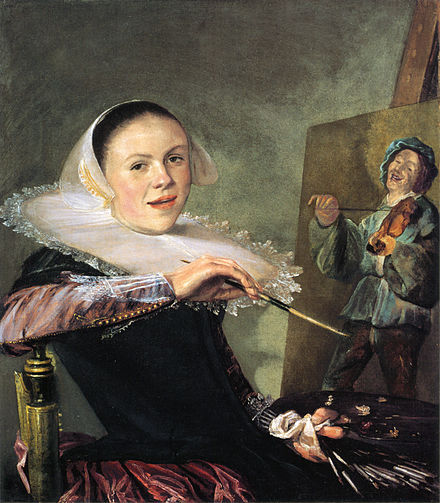
During her life her works were highly recognized, but she got forgotten after her death and rediscovered in the 19th century. In her paintings could be identified the acronym "JL", asually followed by a star, she was the first woman to be inserted in the Guild of St. Luke, the guild Haarlem's artists.
-Artemisia Gentileschi (Italian, 1593-1656)
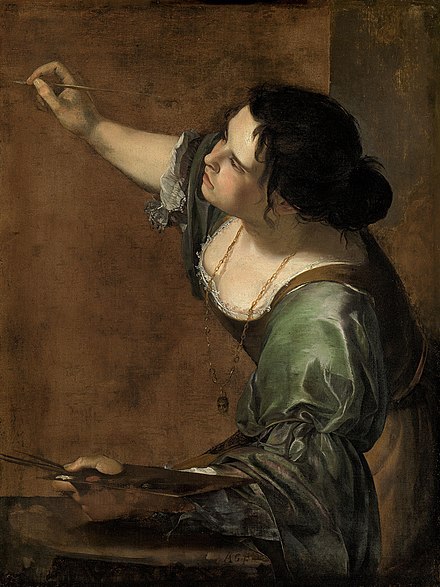
"... Si è talmente appraticata che posso osar de dire che hoggi non ci sia pare a lei, havendo fatto opere che forse i principali maestri di questa professione non arrivano al suo sapere". This is how the father Orazio talked about his nineteen year old daughter to the Medici's court in Florence.
In 1611, Artemisia got raped, and she had to Undergo a humiliating trial, just to marry so that she could "Restore one's reputation" , according to the morality of the time. Only after a few years Artemisia managed to regain her value, in Florence, in Rome, in Naples and even in England, her oldest surviving work is "Susanna and the elders".
-Elisabeth Louise Vigèe Le Brun (French, 1755-1842)
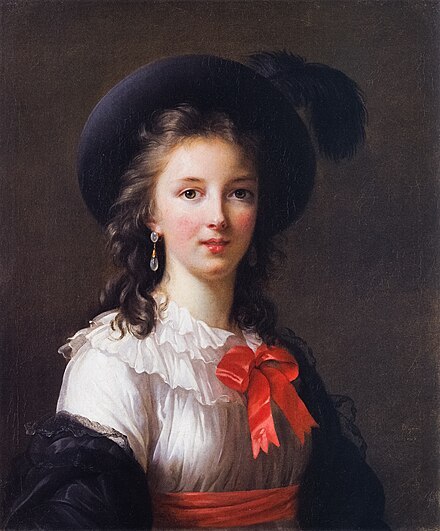
She was a potrait artists who created herself a name during the Ancien Règime, serving as the potrait painting of the Queen of France Marie Antoinette, she painted 600 portraits and 200 landscapes in the course of her life.
-Augusta Savage (Afro-American, 1892-1962)

Augusta started making figures when she was a child, which most of them were small animals made out of red clay of her hometown, she kept model claying, and during 1919, at the Palm Beach County Fair, she won $25 prize and ribbon for most original exhibit. After completing her studies, Savage worked in Manhattan steam laundries to support her family along with herself. After a violent stalking made by Joe Gould that lasted for two decades, the stalker died in 1957 after getting lobotomized. In 2004, a public high school, Augusta Fells Savage Institute of Visual Arts, in Baltimore, opened.
-Marie Ellenrieder (German,1791-1863)

She was known for her portraits and religious paintings. During a two years long stay in Rome, she met some Nazarenes (group of early 19th century German romantic painters who wanted to revive spirituality in art),after becoming a student of Friedrich Overbeck and after being heavily influenced by a friend, she began painting religious image, getting heavily inspired by the Italian renaissance, more specifically by the artist Raphael. In 1829, she became a court painter to Grand Duchess Sophie of Baden.
-Berthe Marie Pauline Morisot (French,1841-1893)
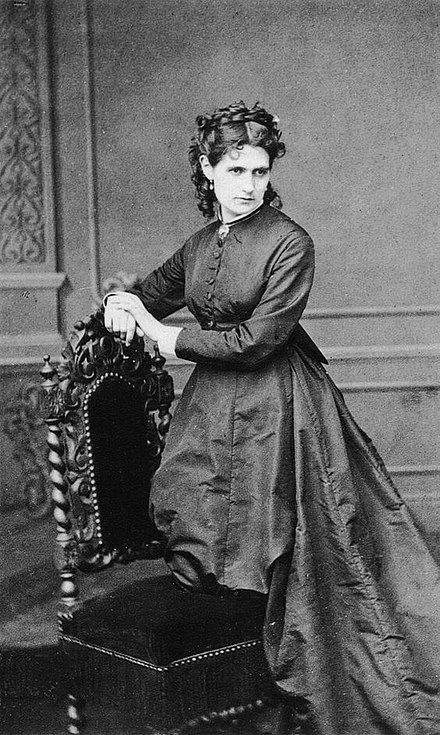
Morisot studied at the Louvre, where she met Edouard Manet, which became her friend and professor. During 1874 she participated at her first Impressionist exhibition, and in 1892 sets up her own solo exhibition.
-Edmonia Lewis or also called "wildfire" (mixed African-American and Native American 1844-1907)
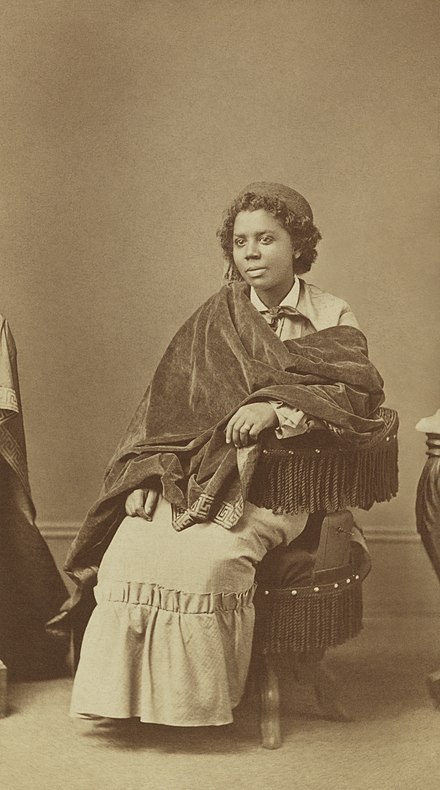
Edmonia was born in Upstate New York but she worked for most of her career in Rome, Italy. She was the first ever African American and Native American sculptor to achieve national and international fame, she began to gain prominence in the USA during the Civil Ware. She was the first black woman artist who has participated and has been recognized to any extent by the American artistic mainstream. She Also in on Molefi Kete Asante's list of 100 Greatest African Americans.
-Marie Gulliemine Benoist (French, 1768-1826)
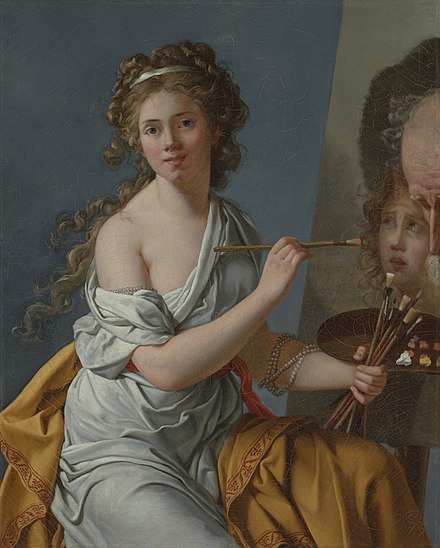
Daughter of a civil servant, Marie was A pupil of Jaques-Louis David, whose she shared the revolutionary ideas with, painting innovative works that have caused whose revolutionary ideals he shared, painting innovative works that caused discussion. She opened a school for young girl artists, but the marriage with the banker Benoist and the political career Of the husband had slowly had effect on her artistic career, forcing her to stop painting. Her most famous work is Potrait of Madeline, which six years before slavery was abolished, so that painting became a simbol for women's emancipation and black people's rights.
-Lavinia Fontana (Italian, 1552-1614)

She is remembered for being the first woman artist to paint an altarpiece and for painting the first female nude by a woman (Minerva in the act of dressing), commissioned by Scipione Borghese.
-Elisabetta Sirani. (Italian, 1698-1665)
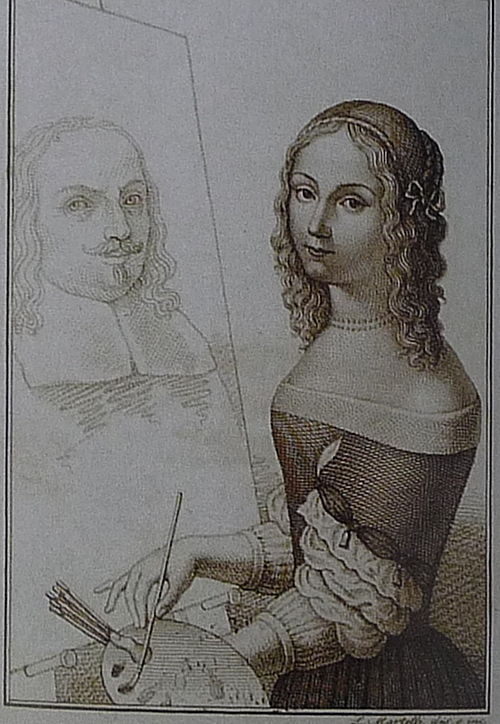
Her admirable artistic skills, that would vary from painting, drawing and engraving, permitted her, in 1660, to enter in the National Academy of S. Luca, making her work as s professor. After two years she replaced her father in his work of his Artistic workshop, turning it into an art schools for girls, becoming the first woman in Europe to have a girls' school of painting, like Artemisia Gentileschi, she represent female characters as strong and proud, mainly drawn from Greek and Roman stories. (ex. Timoclea Kills The Captain of Alexander the Great, 1659).
#judith leyster#artemisia gentileschi#Elisabeth Louise Vigèe Le Brun#Augusta Savage#Marie Ellenrieder#berthe morisot#Edmonia Lewis#Marie Gulliemine Benoist#Lavinia Fontana#Elisabetta Sirani#women artists#renaissance#baroque#art#women in art#artist women#feminism#women history#radical feminists do touch#radical feminists please interact#history#terfblr#terfsafe#cultura#culture
1K notes
·
View notes
Text


𝕾𝖊𝖗𝖕𝖊𝖓𝖙 𝕼𝖚𝖊𝖊𝖓
#renaissance#medieval#victorian#victorian gothic#accessories#fashion#medieval aesthetic#necklace#earrings#medieval art#victorian goth fashion#gothic#goth aesthetic#gothic fashion#goth#goth fashion#modern renaissance#renaissance inspired#renaissance art#serpent#serpent queen#catherine de medici#statement jewelry#handmade#gold#unique gifts#unique fashion#medieval jewelry#historical#art history
8 notes
·
View notes
Text
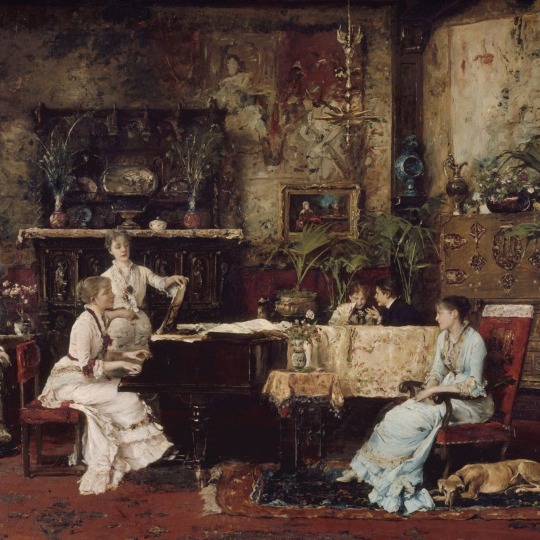



Happy World Art Day! 🌍 🎨 At JSTOR, we're celebrating the vibrant tapestry of creativity that colors our world. From the studios of renowned masters to the cozy corners where emerging talents find their voice, let's honor the spaces that ignite imagination and the artists who bring them to life. Join us in celebrating the power of art to inspire, provoke, and unite us all. Images:
Mihály Munkácsy. The Music Room. 1878. The Metropolitan Museum of Art.
Edgar Degas. Dancers in the Rehearsal Room with a Double Bass. ca. 1882-85. The Metropolitan Museum of Art.
Léon Cogniet. The Artist in His Room at the Villa Medici, Rome. 1817. Cleveland Museum of Art.
Jean-Alphonse Duplessy. Cobbler’s Quarters. 1860s. The Cleveland Museum of Art.
#jstor#world art day#artists#art#fine art#mihaly munkacsy#adolph menzel#edgar degas#leon cogniet#edited to correct a citation
236 notes
·
View notes
Text



"Pendant with Cameo of Marie de Medici" by Georges Bissinger and Carlo Giuliano (circa 1865), "Pedant/Brooch" by François-Désiré Froment-Meurice (1855), "Bracelet Diana" by Alphonse Fouquet (1883) and "Brooch with Portrait of Empress Elisabeth of Austria" by Alphonse Fouquet (1878) presented in “A History of Jewellery: Bedazzled (part 5: 19th Century)” by Beatriz Chadour-Sampson - International Jewellery Historian and Author - for the V&A Academy online, march 2024.
#conferences#inspirations bijoux#email#perle#camee#Medicis#Bissinger#Giuliano#FromentMeurice#Fouquet#ChadourSampson#V&AAcademy#Victoria&AlbertMuseum
40 notes
·
View notes
Text


16/11/24
Marble statue of Aphrodite
Roman, Imperial period, 1st or 2nd century A.D. Copy or adaptation of a Greek statue of the 3rd or 2nd century B.C.
The goddess of love is shown as though surprised at her bath. Originally, her arms reached forward to shield her breasts and pubis in a gesture that both concealed and accentuated her sexuality.
Statues of Aphrodite in the nude proliferated during the Hellenistic period. All were inspired to some degree by the Aphrodite of Knidos, created in the fourth century B.C. by the famous Greek sculptor Praxiteles. That statue, the first major Greek work to show the goddess nude, was celebrated throughout antiquity. This work has the same gesture of modesty and is similar to another Roman copy, the so-called Medici Venus, which has stood in the Tribuna of the Uffizi Gallery in Florence since 1688.
#photographers on tumblr#original photography#dark academia#dark academia aesthetic#classic academia#classic academia aesthetic#chaotic academia#chaotic academia aesthetic#art#greek mythology#cottagecore#cottagecore aesthetic#cottage aesthetic#dark cottagecore#nature photography#nature#naturecore#nature aesthetic#gardencore#earthcore#fairycore#fairy aesthetic#softcore#soft aesthetic#autumn#autumncore#autumn aesthetic
57 notes
·
View notes
Text


•✦ [ 13. 𝐁𝐋𝐎𝐎𝐃𝐑𝐎𝐒𝐄 ] ✦• a header / character template.
─── 𝒅𝒆𝒔𝒄𝒓𝒊𝒑𝒕𝒊𝒐𝒏.
celebrating spooky season, this is a psd inspired by vampires and bloody roses. this is a very easy to use template and looks best with THIS psd coloring. as per usual, if you have any questions, feel free to ask! enjoy!
─── 𝒆𝒙𝒕𝒓𝒂 𝒅𝒆𝒕𝒂𝒊𝒍𝒔.
fonts: medici text, marion
PSD coloring is NOT INCLUDED [ click here for psd ]
images do not belong to me and are credited to their rightful owners.
do not copy, do not steal, or monetize. [ read my rules ]
tip me at my coffee jar ♥
please credit me if you use the content.
please [ like/reblog ] this if you intend to use.
•✦── 𝐚𝐜𝐜𝐞𝐬𝐬 𝐠𝐫𝐚𝐧𝐭𝐞𝐝 𝐢𝐧 [ 𝐝𝐢𝐬𝐜𝐨𝐫𝐝 ] 𝐬𝐨𝐮𝐫𝐜𝐞 𝐥𝐢𝐧𝐤. ──✦•
61 notes
·
View notes
Text
sigh. do i need more ideas? no. do i have more ideas? of course
abbott!valentino receives a very curious guest from the county of barcelona who claims that he's going on a holy pilgrimage to rome. all is well and good. problem: they are more or less virtually isolated due to winter and the fact it is the handwavy late 1300s and you have new outbreaks of plague every so often.
and said guest always has a convenient excuse to avoid mass and the sacraments.
(and god is he handsome. no less fair than an angel. the kind of face that inspires nuns to dream of being taken over by the holy spirit. dark-eyed and intense. laughs too loudly in the quiet of the monastery, shameless. he clasps valentino's hand in his own and kisses it, mouth hot against his fingers. thank you for your generosity, father.)
cue demon!marc. who now has a very particular interest in getting one immortal soul to stumble. just a little, if you will.
more under the cut because i have Thoughts tm.
so. this is no particular monastery. you can think san giorgio in venice, or maybe pomposa near ferrara. in short: very rich, very influential, lots of land. suitable for one politically savvy valentino rossi, of course, but still firmly under the ora et labora rule.
this is a place of contemplation sanctifying work. if valentino's table is always, well, generous, it's only because he's providing to his guests who don't adhere to his order's strict frugality. if he's a great hunter and rider, it's only to provide to his flock. if he walks around with a mitre ornamented with gold, it's because of the generosity of the good folk of christ.
and marc finds it hilarious. he so dearly loves hypocrites, liars and holy men. he wants this one all for him.
it's no hardship, to distract valentino from properly attending the hours (he's simply sampling from the abbey's excellent wine, they're beyond skilled, really, his most sincere compliments. and if his mouth is stained dark and inviting, well, wasn't it god who made men beautiful).
to go hunting with him and smile up once they break off from the rest of their entourage, his hands stained with blood, his eyes fiery. you're a remarkable marksman, valentino says, strangled, while marc kneels on the snow before him, watching the poor hart bleed to death.
and listen, valentino may be more prince than clergyman (it's the right era for that. there are anti-popes in avignon. the medicis, sforzas, borgias, the viscontis, della roveres, orsinis, borghese, etc, etc, etc are either right around the corner or there already. it's the time of the cardinal-nephews) but he isn't stupid.
he keeps getting those letters from luca (maybe a condottieri. maybe a local nobleman. if this is venice, i keep seeing him as serving one of the avogadori de comùn, aka public prosecutors, or in the quarantia) about how the crops are failing, and the plague is getting worse, and people are gettting a little wild. more crimes. more violent crimes.
the local confessor is very worried about the souls of valentino's monks, too. he cannot get in detail, no, but many are experiencing doubt and temptation. strange dreams. unwilling desires.
valentino smiles, thinly. these are trying times, he says, the very picture of sorrowfulness in his artfully dyed habit. he's thinking about—how he dreams at night. tanned hands braced against his chest. the glimspe that he caught of marc's thighs, smooth, strong. how exactly he thought about extracting payment, after marc pressed a silver necklace into his hands, eyes downcast, father, i have nothing else to give, but take this, i don't wish to impose on the generosity of the servants of christ.
#thank you name of the rose#i didn't need this and yet#anyway if you want to know more about demon!marc tempting a very bad priest valentino i'm always up for it#anyway pecco is valentino's claustral prior (his second in command) and he's fucking SUFFERING#and marc has a very ill-tempered somewhat violent horse that no one can get close to (it's his honda baby)#i haven't nailed down the rest of the academy yet#rosquez#abbey au
31 notes
·
View notes
Note
How about Roleswap! Auditore Family?
What happen if one of them (Giovanni, Petruccio, Federico or Claudia) takes the place of Ezio?
Like Ezio is one of the executed and Federico is the only Auditore man that survives?
Or Claudia is the only Auditore child left?
So let’s set some ground rules first.
Ezio can only replace one of them. This means that the only one of them will survive.
This does not take inconsideration what would happen to Desmond’s bloodline unless we set this as a time travel scenario where Desmond fucked up so badly he got Ezio killed instead. We’re focusing on the Auditores in this one.
.
Giovanni:
Giovanni would probably be angst-y as hell for one main reason. He watched all of his sons died, unable to save them because he trusted the wrong man. His relationship with Maria would take a serious hit and he’d grow to be overly protective of Claudia. He would probably choose to escape to Spain like Ezio did before Mario reminds him that he was being hunted. Even if he was to go elsewhere, the Templars will hunt him and his family down.
Another additional wrinkle in this one is that his relationship with the Medici could change as well. He could start to understand that his closeness with Lorenzo only made it so much easier for the Templars to find him and his family.
He would absolutely not hesitate to kill Rodrigo Borgia and the Apple would be able to tempt him as well.
.
Federico:
This would actually be the closest to Ezio’s story beat. The only real difference is that Federico would see himself as weak and a failure for being unable to save his father and brothers. He’d be more serious than Ezio and it would actually take less time for him to be trained as he was already in the middle of his Assassin training anyway.
He would also not hesitate to kill Rodrigo Borgia if given a chance. There would also be a scene with him and Cristina similar to the flashback in ACB. In this one though, Federico would apologize for being unable to save Ezio.
.
Petruccio:
Oh, man. We’re going to play with Petruccio a bit.
A situation we can use is that Petruccio learns of the Shroud and gets Claudia to help him find it. He uses the Shroud to heal his body but this has the dire consequence of awakening the Isu inside the Shroud that starts haunting him like his own personal Bleeding Effect hallucination. In this one, Petruccio is much more connected to the POEs because of the Shroud.
But you know what would be fun?
If Petruccio continues to have a weak body and replaces Claudia as the ‘administrator’ of Monteriggioni. But that’s what they want everyone to believe. Claudia becomes his knight while he becomes the mastermind hiding behind the huge shadows cast by their uncle. The death of his father and brothers shed whatever innocence he had left and he becomes a ruthless player, moving all the pieces in the board while pretending to just be a weak sickly young man. An inspiration that would guide Machiavelli’s hands in writing the Prince.
.
Claudia:
Honestly, Claudia would probably spend a year or more being lost. Her mother is catatonic, her father and brothers are dead, she only managed to get her mother out because her maid knew people who helped them and contacted her uncle to meet with them.
She wouldn’t even think of escaping to Spain. Where would they even stay there?
She knew that the best choice for her is to marry a powerful man who could protect her and her mother but, at the same time, she couldn’t even think of any man touching her without throwing up.
Learning the sword had been her way of trying to ‘heal’ herself. Mario saw her potential and taught her the ways of the Brotherhood.
She wanted revenge but, more importantly, she wanted to protect her mother and the second home that accepted them.
Honestly, out of all of them? Claudia would be the most ruthless of them all because she knows she can’t afford to be weak.
She can’t allow herself to be weak.
#assassin's creed#ask and answer#teecup writes/has a plot#fic idea: assassin's creed#ezio auditore#giovanni auditore#federico auditore#petruccio auditore#claudia auditore
48 notes
·
View notes
Text
Primo Emeritus: Florence.
This is the first of my posts where I locate each Papa in Italian cities based on the occult influences/history of each city. I hope you find it interesting and useful!
Primo | Secondo | Terzo

Primo Emeritus, The Old One, the embodiment of all that is sacred. A personality like his deserves to be located in an ancient city full of art, poetry, and history, shaped by the esoteric and alchemical obsessions of the Medici family, amidst the enduring shadow of centuries-old Satanic cults.
Let’s see why I have chosen Florence for Primo.
In this chapel of ritual…

From the early 70s to the late 80s, a series of murders occurred in various regions of middle-north Italy, with the most infamous taking place in Tuscany, known as the case of the 'Monster of Florence' (Mostro di Firenze), which resulted in the deaths of 14 people - officially, but it is believed there were way more.
The theory is that these murders were part of a large network of Satanic rituals involving influential figures from Rome, Perugia, and Florence. This network is supposedly still active. The original cult allegedly responsible for initiating these rituals seems to be the 'Rosa rossa' (Red Rose) cult.
A fertile ground for writing Ritual...
2. The creator of Hell.

Florence is the birthplace of Dante Alighieri, the renowned author of the Divine Comedy and the creator of the now canonical structure of Hell.
Primo could have had many more things in common with Dante than we expect: indeed, it is said that Alighieri was part of an esoteric cult named ‘Fedeli d’Amore’ (Loyals to Love), probably affiliated with the Templars. From there, Dante is said to have drawn inspiration for his symbolic and esoteric tales, as well as his passion for numbers.
Keep an eye on Dante, as he will eventually come back in the next chapters.
3. The ghost behind the open window.
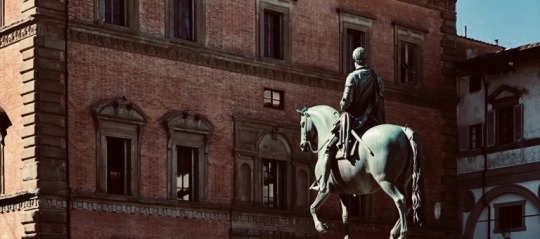
It’s not a Ghost story without an actual ghost.
In Piazza Santissima Annunziata, there is a building, Palazzo Grifoni, that holds a mysterious detail: a window that remains open at all times, whether day or night, summer or winter. Legend has it that a woman of the Grifone family bid farewell from that window to her lover, likely Ferdinando I, who departed for war. She waited for him by that same open window throughout her life, but he never returned, dying in battle. When she passed away, the window was finally closed. However, soon after, numerous mysterious events happened in the building, to the point the residents concluded that the building was haunted by the ghost of the woman, and they have kept the window open ever since not to upset her.
But that's not all: the Ferdinando I statue placed in the square, has his face turned to look right to that window… At the very end, he finally came back to her.
4. The Boboli alchemical garden.
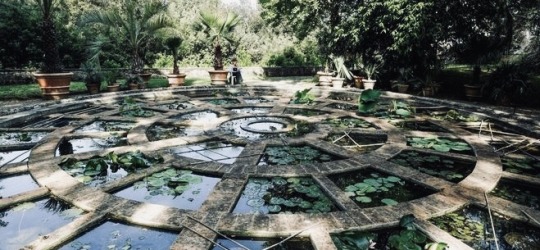
Boboli represents a very particular case of an alchemical garden conceived to be ‘accessible’ only to those who have a strong alchemical and esoteric knowledge. It is built as a symbolic route where you can contemplate the principles of magical and alchemical doctrine along the way. You’ll be welcomed by two fountains, placed one on top of the other: the Mose’s (it is an indoor fountain) and the Carciofo’s (artichoke). They are believed to represent the esoteric concept of “as above so below”, but the references to esoteric concepts are present along the whole garden.
Primo would have surely loved this place.
#ghost band#the band ghost#primo emeritus#papa emeritus i#papa primo#italian cities#ghost theories#Ghost band theories
94 notes
·
View notes
Text
Sword Catcher: Worldbuilding
Who rules Castellane?
Castellane is a city-state — it has its own government and royal family. Part of my inspiration for Sword Catcher was Venice during the Silk Road era, and families like the famous Borgias and Medicis. Castellane’s government consists of a royal family and a Council of Twelve — twelve families, each of whom holds a charter that gives them ownership over a certain kind of good that is traded through the continent of Dannemore. These are the Charter Families; they are the richest in Castellane, and Charters are passed down through families, like an inheritance — though the ruling family, the Aurelians, has the power to grant charters and also to take them away.
The Charter Families
The Uzecs have quite a bit of sway as the holders of the Wine Charter.
A popular man is Mathieu Gremont, who holds the Coffee and Tea Charter.
Fabulous Lupin Montfaucon always has the latest fashions, as appropriate for the Charter holder for fabrics.
Joss Falconet is an old friend of Prince Conor’s, and owns the Spice Charter. More on him later!
House Gasquet controls all the oil and perfume coming in and out of the city.
Lady Alleyne, the mother of Antonetta, is in charge of the valuable Silk Charter and makes sure she and her daughter are always in the finest silk dresses.
The Cazalet Family has owned the Banking Charter for so long, coins are often called “cazalets”.
House Roverge owns the Dye Charter. House Sardou has the Glass Charter,
House Raspail Timber, and Alonse Esteve owns the Horse Charter.
They have their meetings in the Dial Chamber, whose seats are arranged to look like the numbers on a clock.
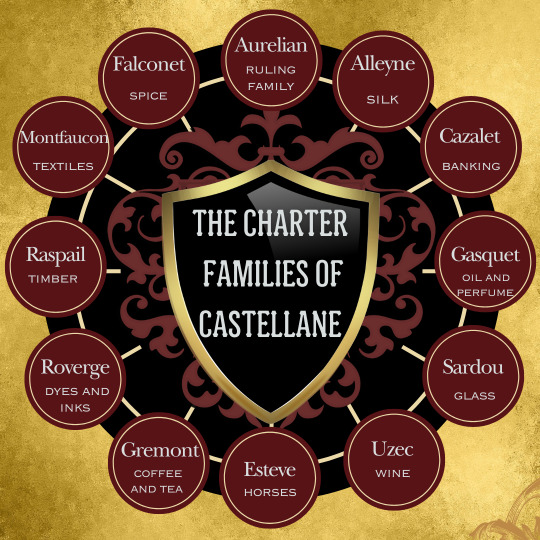
Sitting at midnight is House Aurelian, the Royal Family, whose charter is kingship. At these meetings the fates of cities and countries are decided with the stroke of a pen. It used to be the pen of King Markus, but as he has grown weaker with a mysterious illness, that pen has found itself in the hand of his son, Conor Aurelian…possibly the least responsible person in Castellane.
(Conor art by Sasha Coleman.)
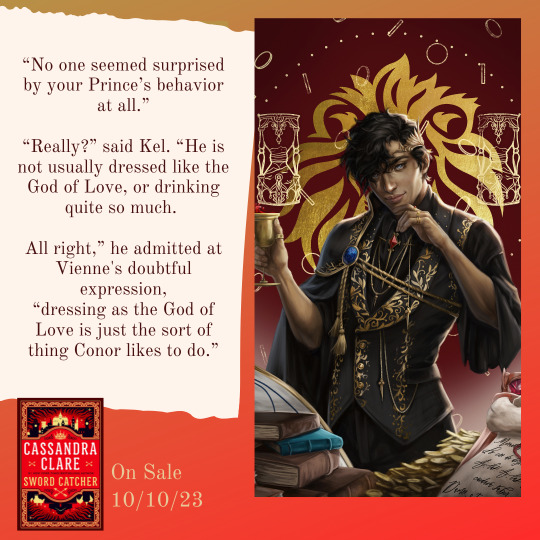
371 notes
·
View notes